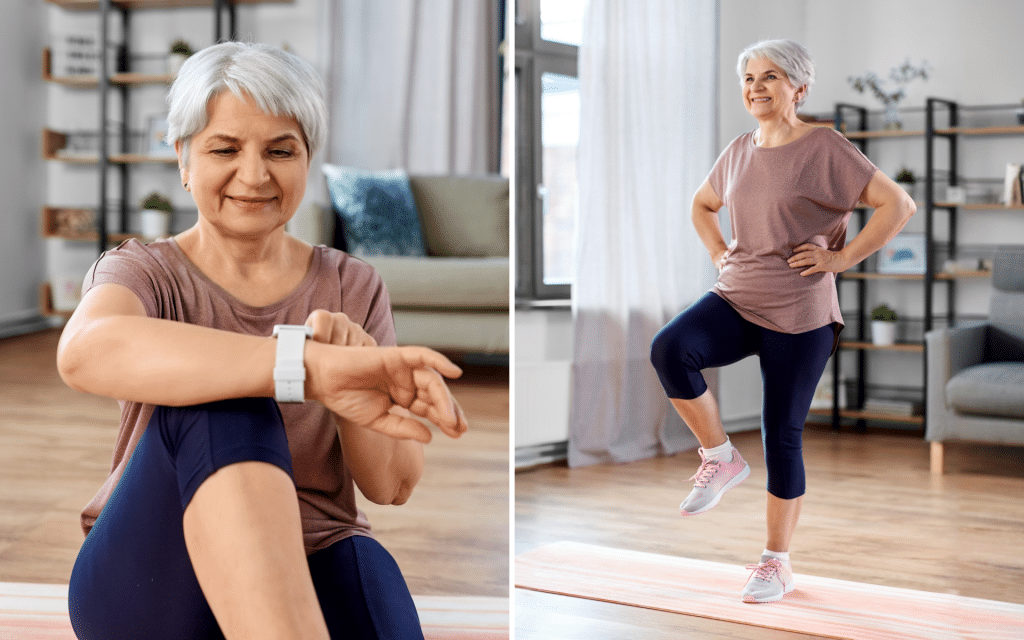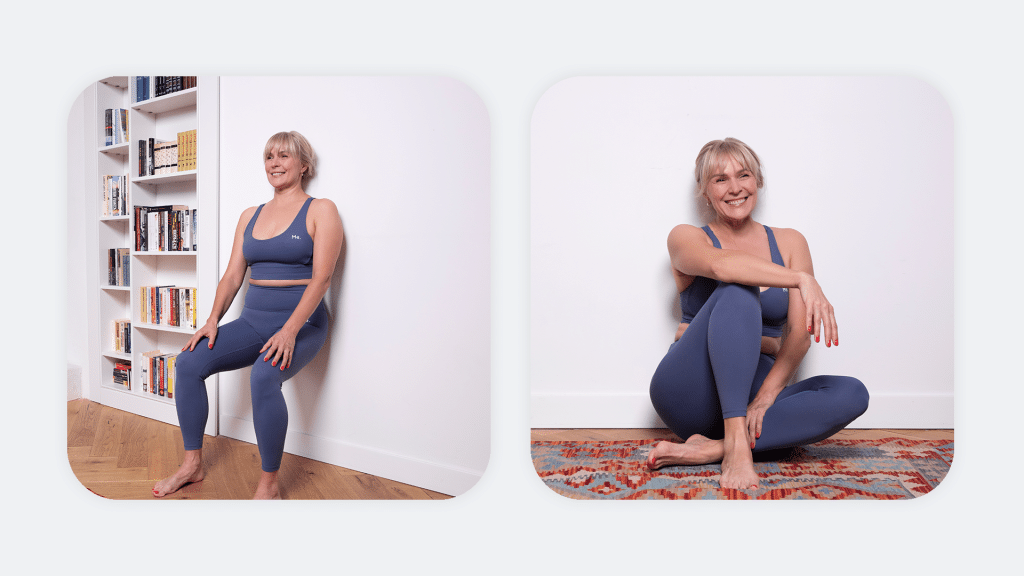Many people can benefit from the gentle, functional practice that is calisthenics. It’s a great way to maintain and improve your overall strength, flexibility, balance, and mobility. And the best part is it can be done by people of all ages and fitness levels – including seniors (1).
As you age, your body becomes more susceptible to muscle loss, decreased bone density, joint stiffness, and other age-related issues (2). This makes it even more important for seniors to incorporate regular exercise into their routines in order to maintain their physical independence and quality of life.
Calisthenics exercises provide a low-impact option for seniors who want to remain active without putting too much strain on their bodies. These exercises use your body weight as resistance, which makes them safe and effective for seniors while allowing them to reap all the health benefits of regular exercise.
However, you should always make sure to contact a medical professional before you get started on any new exercise program. This is the best way to ensure your body can handle a new routine.
Without further ado, here are 5 gentle and effective body weight exercises for seniors that can be incorporated into their daily routines for a full-body workout:
Key Benefits of Calisthenics for Seniors
With its gentle and functional approach, calisthenics offers a multitude of benefits for seniors. Incorporating these exercises into their daily routines can lead to (3):
Gentle Strength Building with Calisthenics
By utilizing their own body weight as resistance, seniors can engage in low-impact strength-building exercises. Calisthenics helps maintain and improve muscle strength, which is essential for performing daily activities and maintaining independence as you age.
Improving Balance and Mobility
Body weight exercises for seniors focus on stability and body control, thereby helping seniors improve their balance and mobility.
Enhancing these aspects through mobility exercises for seniors reduces the risk of falls and injuries, which allows older adults to maintain active lifestyles.
Emotional and Social Benefits of Staying Active
Regular engagement in calisthenics exercises provides emotional well-being for seniors. Exercise has been proven to release endorphins, which reduces stress and boosts your mood. In addition, participating in group classes or exercising with friends fosters social connections and combats feelings of isolation.
Incorporating calisthenics into a senior’s fitness routine can have a profound impact on their overall well-being, and mindset and help in improving balance and strength.
BetterMe: Health Coaching app helps you achieve your body goals with ease and efficiency by helping to choose proper meal plans and effective workouts. Start using our app and you will see good results in a short time.
Safe Preparation: Warm-Up and Safety Tips for Calisthenics
To ensure a safe and effective calisthenics session for seniors, it’s important to prioritize proper warm-up exercises and follow some essential safety tips. By incorporating these practices into your routine, you can minimize the risk of injury and maximize the benefits of your workout.
Effective Warm-Up Exercises
Before you dive into your calisthenics routine, take a few minutes to warm up your muscles and prepare your body for the exercises ahead (4). Here are some effective warm-up exercises to consider:
- Joint Rotations: Gently rotate your wrists, ankles, neck, and shoulders to increase blood flow and loosen up the joints.
- Cardiovascular Warm-Up: Engage in light cardio activities such as brisk walking or cycling for a few minutes to raise your heart rate and warm up your muscles.
- Dynamic Stretches: Perform dynamic stretches like arm circles, leg swings, and lunges to improve flexibility and increase range of motion.
Recognizing Physical Limits
While calisthenics can offer numerous benefits, it’s essential to listen to your body and recognize your physical limits. Here are some tips to keep in mind:
- Start Slow: If you’re new to calisthenics or returning after a break, start with simpler exercises and gradually increase intensity and complexity over time.
- Pay Attention to Form: Proper form is essential for preventing injuries. Focus on maintaining proper alignment and technique throughout each exercise.
- Rest and Recovery: Allow your body enough time to rest and recover between workouts to prevent overexertion and muscle fatigue.
- Modify and Progress: If an exercise feels too challenging, modify it or use progressions to gradually build up your strength and skill level.
- Consult a Professional: If you have any existing health conditions or concerns, it’s always a good idea to consult a healthcare professional or qualified fitness trainer before you start any new exercise regimen.
By incorporating a safe and effective warm-up routine and respecting your physical limits, you can make the most of your calisthenics practice while reducing the risk of injury and ensuring a successful workout session.
Read more: Beginner Walking Program for Seniors: Schedule, Tips, and More
Effective Calisthenics Exercises for Seniors
Calisthenics is a fantastic way for seniors to maintain strength, mobility, and balance in a gentle, low-impact manner. Below, we highlight five effective exercises that are designed to target specific areas while keeping safety and accessibility in mind.
1. Seated or Modified Squats for Leg Strength
Benefits: Squats are excellent for building leg strength, improving mobility, and supporting everyday movements such as standing up or sitting down. They also help boost balance and lower body endurance.
How to Perform Safely:
- Sit on a sturdy chair with your feet flat on the ground, hip-width apart.
- Slowly stand up by pressing through your heels, keeping your back straight.
- Lower yourself back into the chair in a controlled motion.
Modifications: If standing completely is challenging, you can perform partial squats by lifting yourself just slightly off the chair. If you’re more advanced, try air squats without the chair, holding onto a wall or countertop for support.
2. Wall Push-Ups for Upper-Body Strength
Benefits: Wall push-ups strengthen the chest, shoulders, arms, and core without putting any strain on the wrists or shoulders. They’re perfect for improving muscle tone and posture.
How to Perform Safely:
- Stand an arm’s length away from a wall with your hands flat against it at shoulder height.
- Lean forward, lowering your chest toward the wall while keeping your back straight and your elbows tucked at a 45-degree angle.
- Push back to the starting position.
Modifications: If this feels too easy, step further away from the wall to increase the resistance. For a lighter modification, reduce the depth of your push-up by only leaning slightly into the wall.
3. Seated Leg Raises to Enhance Stability
Benefits: This exercise targets the quadriceps and improves leg strength, stability, and balance. It also helps maintain mobility in the knees and hips.
How to Perform Safely:
- Sit in a sturdy chair with your back straight and your hands resting on the sides for support.
- Extend your right leg straight out, lifting it to hip level (or as high as feels comfortable). Be cautious of arching your lower back.
- Hold for a second, then lower it back down. Repeat with the left leg.
Modifications: If extending to hip level is too difficult, lift your leg just a few inches off the ground. To make it more challenging, you can hold the leg extension for a longer duration.
4. Arm Circles for Shoulder Mobility
Benefits: Arm circles enhance shoulder flexibility, improve range of motion, and boost circulation in the upper body.
How to Perform Safely:
- Stand or sit upright with your arms extended straight out to your sides, parallel to the floor.
- Make small circles with your arms, gradually increasing the circle size.
- Perform for 15–30 seconds, then reverse the direction.
Modifications: If you struggle to keep your arms raised for long, do shorter sets or take breaks between repetitions. For added intensity, hold light weights or water bottles in your hands.
5. Gentle Core Twists for Back and Core Strength
Benefits: Core twists strengthen the abdominal and oblique muscles while improving spinal mobility and relieving lower back stiffness.
How to Perform Safely:
- Sit in a chair with your feet flat on the floor.
- Place your hands on your knees or clasp them in front of your chest.
- Slowly rotate your torso to the right as far as is comfortable, keeping your hips stable.
- Return to the center and repeat on the left side.
Modifications: If turning fully feels difficult, perform smaller rotations within your range of motion. To increase the difficulty, hold a light weight or a water bottle during the twists.
Crafting a Weekly Routine for Calisthenics for Seniors
Designing a calisthenics routine that balances strength, mobility, and rest is the key to supporting the health and well-being of seniors. A well-structured plan ensures all major muscle groups are engaged while allowing time for recovery, which is essential for maintaining progress without risking injury.
Here’s a sample calisthenics senior fitness routine that balances activity and rest:
Day 1 (Monday): Strength and Mobility
- Seated or Modified Squats (3 sets of 8–10 reps)
- Wall Push-Ups (3 sets of 8–10 reps)
- Arm Circles (30 seconds forward and 30 seconds backward, 2 sets)
Day 2 (Tuesday): Light Activity and Stretching
This is an active recovery day. Consider a 20-minute walk outdoors, followed by light stretching to keep the body moving without overexertion.
The BetterMe: Health Coaching app will provide you with a host of fat-frying fitness routines that’ll scare the extra pounds away and turn your body into a masterpiece! Get your life moving in the right direction with BetterMe!
Day 3 (Wednesday): Core and Stability
- Gentle Core Twists (3 sets of 8–10 twists per side)
- Seated Leg Raises (3 sets of 8 reps per leg)
- Relax with deep breathing or yoga-inspired stretching.
Day 4 (Thursday): Rest Day
Give your muscles a chance to recover. Use this day for self-care activities or meditation.
Day 5 (Friday): Full-Body Engagement
- Seated or Modified Squats (3 sets of 8–10 reps)
- Wall Push-Ups (3 sets of 8–10 reps)
- Gentle Core Twists (3 sets of 8–10 twists per side)
Day 6 (Saturday): Light Activity and Stability Work
- Go for a 15–20 minute walk or engage in a favorite leisure activity such as gardening.
- Perform a light round of arm circles or seated leg raises (1–2 sets for each).
Day 7 (Sunday): Rest or Gentle Stretching
Stay off your feet and allow your body to fully recover. Gentle exercises for seniors such as stretching or mindfulness exercises such as deep breathing can help keep you relaxed and limber.
Adjusting Workouts Based on Progress
Your calisthenics routine should evolve as your strength and confidence grow. Here’s how to modify your plan over time while prioritizing safety:
- Increase Reps or Sets Gradually: Start with fewer repetitions and work your way up as your body adapts. For example, if you start with 8 reps of wall push-ups, aim for 10–12 reps over time.
- Add Light Resistance: Use light weights, resistance bands, or handheld items such as water bottles to increase the challenge for specific exercises.
- Focus on Form Over Speed: Ensure each movement is controlled and precise. Never rush, especially when increasing difficulty, to avoid strain.
- Listen to Your Body: Take extra rest days if you feel fatigued or sore. Pain is a sign that modifications or a break may be needed.
The Importance of Rest Days
Strength training for seniors at home should prioritize rest as it is essential for improving strength and endurance. Rest days offer your muscles the chance to recover and rebuild, which is essential for staying active in old age in the long term (6).
On rest days, you should prioritize hydration, good nutrition, and gentle movement to enhance your recovery.
Staying Motivated with Calisthenics for Seniors
- Setting Personal Goals and Celebrating Progress
Setting personal goals is a powerful motivator that keeps you focused and engaged in your calisthenics routine. Start with small, achievable goals and gradually increase the intensity or duration of your workouts as you progress.
Celebrate each milestone you achieve, whether it’s increasing the number of repetitions or mastering a new exercise. Acknowledging your progress along the way can boost your confidence and keep you motivated to continue pushing forward.
- Keeping Workouts Fun and Engaging
To maintain motivation, it’s important to keep your calisthenics workouts fun and enjoyable. Find exercises and variations you genuinely enjoy and incorporate them into your routine.
Experiment with different workout formats, such as circuit training or interval training, to add variety and a challenge. You can also try working out with a friend or joining a group class to make your workouts more social and engaging.
- Consistency for Lifelong Benefits
Consistency is key when it comes to reaping the long-term benefits of low-impact exercises for seniors. Aim for regular workouts, ideally on most days of the week, to build strength, flexibility, and endurance over time.
Read more: 7 Back Mobility Exercises for Better Posture and Reduced Injury Risk
Staying Active Together: Build Connections with Calisthenics
Incorporating calisthenics into a group setting can bring a whole new dimension to your fitness journey.
Why Group Workouts Are Great for Seniors
Group workouts create a space where seniors can connect with others who share similar fitness goals and interests. This interaction helps combat feelings of loneliness and isolation, fostering friendships and a sense of belonging (7). For many seniors, these connections become just as valuable as the physical benefits of exercising.
The group dynamic naturally encourages participants to remain committed and put in their best effort. Seeing others meet their fitness goals can inspire seniors to stay consistent with their routines. Group members often hold each other accountable, which makes it less likely for someone to skip a session.
Exercising in a group can turn a workout into a social event. Sharing jokes, encouraging each other, and celebrating progress as a group all make the experience much more enjoyable. This added fun factor can help seniors view exercise as a positive and rewarding activity, rather than a chore.
How to Find Classes and Communities Near You
Finding calisthenics classes and communities near you is easier than ever. Here are a few ways to get started:
- Check local fitness centers, community centers, and gyms for calisthenics classes or group workouts that are specifically designed for your age group or fitness level.
- Reach out to senior centers or organizations that are focused on senior health and wellness. They may offer calisthenics classes or have resources to connect you with local groups.
- Search online platforms and social media for local calisthenics for seniors communities or groups. These platforms often provide information about meetups, workshops, and online communities where you can connect with fellow enthusiasts.
Calisthenics is ideal for seniors as it is low-impact, improves strength, mobility, and balance, and can be adapted for all fitness levels. It uses body weight for resistance, which makes it effective and a safe physical activity for elderly individuals (1, 8). Seniors can safely practice calisthenics 2–3 times a week, allowing rest days in between for recovery. Gentle exercises for seniors such as walking and stretching on non-workout days can help maintain mobility. Yes, most calisthenics exercises can be modified to accommodate limited mobility. For example, seated versions of squats or leg raises and wall push-ups are excellent options for seniors who have physical limitations. Other low-impact exercises for seniors that can be incorporated into a calisthenics routine include chair Pilates and chair yoga. No special equipment is required for calisthenics. Seniors can use sturdy chairs, walls, or resistance bands for support or added resistance when required, but exercises are primarily reliant on body weight.Frequently Asked Questions
Why is calisthenics for seniors ideal?
How often should I practice calisthenics?
Are modifications available for limited mobility?
Do I need any special equipment?
The Bottom Line
Calisthenics is an excellent workout option for seniors that offers benefits such as improved strength, mobility, and balance while being adaptable to various fitness levels. These exercises rely on body weight and can often be performed with simple modifications, which makes them accessible for those with limited mobility. They promote overall well-being and independence, which are essential for maintaining a good quality of life. However, safety is key and seniors should always listen to their bodies, avoid overexertion, and consult healthcare professionals if they have any concerns.
DISCLAIMER:
This article is intended for general informational purposes only and does not serve to address individual circumstances. It is not a substitute for professional advice or help and should not be relied on for making any kind of decision-making. Any action taken as a direct or indirect result of the information in this article is entirely at your own risk and is your sole responsibility.
BetterMe, its content staff, and its medical advisors accept no responsibility for inaccuracies, errors, misstatements, inconsistencies, or omissions and specifically disclaim any liability, loss or risk, personal, professional or otherwise, which may be incurred as a consequence, directly or indirectly, of the use and/or application of any content.
You should always seek the advice of your physician or other qualified health provider with any questions you may have regarding a medical condition or your specific situation. Never disregard professional medical advice or delay seeking it because of BetterMe content. If you suspect or think you may have a medical emergency, call your doctor.
SOURCES:
- Calisthenics: An effective, low-frills way to stay fit (2024, health.harvard.edu)
- Ageing Process and Physiological Changes (2018, intechopen.com)
- The advantages of body-weight exercise (2024, health.harvard.edu
- Warm Up, Cool Down (2024, heart.org)
- Why Rest Days Are Important for Muscle Building (n.d., blog.nasm.org)
- Exercise interventions for older adults: A systematic review of meta-analyses – ScienceDirect (2021, sciencedirect.com)
- Group-based physical activity as a means to reduce social isolation and loneliness among older adults (2021, pubmed.ncbi.nlm.nih.gov)
- Exercise interventions for older adults: A systematic review of meta-analyses (2021, sciencedirect.com)














